|
Volunteering for West Bay Opera is always
entertaining…
Top | Madama Butterfly (2009) | Orfeo ed Euridice | Carmen (2008) | Der fliegende Holländer | Così fan tutte (2008) | Cavalleria rusticana & Pagliacci | The Queen of Spades | Macbeth | The Rake’s Progress | Manon Lescaut | The Magic Flute | The Threepenny Opera | Lucia di Lammermoor | La Clemenza di Tito | Don Giovanni | The Barber of Seville | Viva la mamma | La Périchole | Un ballo in maschera | Tosca | La bohème | Marriage of Figaro | Faust | Tales of Hoffmann | Tartuffe | La Traviata | City of Mahagonny | Così fan tutte | Madama Butterfly (1999) | The Consul | Carmen | The Italian Girl in Algiers | The Turn of the Screw | Il Trovatore
| Madama
Butterfly (2009) |
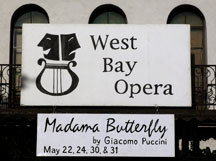 |
This opera is our third repeat at West Bay Opera, but we
love the music even though it always makes us cry. We had many
versions to listen to while Stan worked on the titles and I
worked on pages for the costumes, the set, and to explain the
story of Madama Butterfly. When we arrived for the
dress rehearsal, Prince
Yamadori’s chair was enjoying the fresh air, while
the parasols napped back
stage.The origami flowers waited
patiently while the geishas took
a break. Filmo came to help fire
the cannon the most exciting part of the opera for me.
|
Top | Madama Butterfly (2009) | Orfeo ed Euridice | Carmen (2008) | Der fliegende Holländer | Così fan tutte (2008) | Cavalleria rusticana & Pagliacci | The Queen of Spades | Macbeth | The Rake’s Progress | Manon Lescaut | The Magic Flute | The Threepenny Opera | Lucia di Lammermoor | La Clemenza di Tito | Don Giovanni | The Barber of Seville | Viva la mamma | La Périchole | Un ballo in maschera | Tosca | La bohème | Marriage of Figaro | Faust | Tales of Hoffmann | Tartuffe | La Traviata | City of Mahagonny | Così fan tutte | Madama Butterfly (1999) | The Consul | Carmen | The Italian Girl in Algiers | The Turn of the Screw | Il Trovatore
Top | Madama Butterfly (2009) | Orfeo ed Euridice | Carmen (2008) | Der fliegende Holländer | Così fan tutte (2008) | Cavalleria rusticana & Pagliacci | The Queen of Spades | Macbeth | The Rake’s Progress | Manon Lescaut | The Magic Flute | The Threepenny Opera | Lucia di Lammermoor | La Clemenza di Tito | Don Giovanni | The Barber of Seville | Viva la mamma | La Périchole | Un ballo in maschera | Tosca | La bohème | Marriage of Figaro | Faust | Tales of Hoffmann | Tartuffe | La Traviata | City of Mahagonny | Così fan tutte | Madama Butterfly (1999) | The Consul | Carmen | The Italian Girl in Algiers | The Turn of the Screw | Il Trovatore
| Carmen
(2008) |
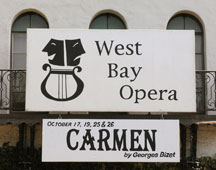 |
This show was our second repeat with West Bay Opera, since
we worked the 1999 Carmen production.
We had several versions of this opera to choose from while I
worked on the pages to show the costumes and the set, while
Stan prepared the titles. We missed the rehearsals and opening
night since we were in Baltimore being awarded the Anthony
Award for Best Mystery Website. So the Ghost
Light was in charge most of the time. Here are some performance
pictures
. |
Top | Madama Butterfly (2009) | Orfeo ed Euridice | Carmen (2008) | Der fliegende Holländer | Così fan tutte (2008) | Cavalleria rusticana & Pagliacci | The Queen of Spades | Macbeth | The Rake’s Progress | Manon Lescaut | The Magic Flute | The Threepenny Opera | Lucia di Lammermoor | La Clemenza di Tito | Don Giovanni | The Barber of Seville | Viva la mamma | La Périchole | Un ballo in maschera | Tosca | La bohème | Marriage of Figaro | Faust | Tales of Hoffmann | Tartuffe | La Traviata | City of Mahagonny | Così fan tutte | Madama Butterfly (1999) | The Consul | Carmen | The Italian Girl in Algiers | The Turn of the Screw | Il Trovatore
| Der
fliegende Holländer (2008) |
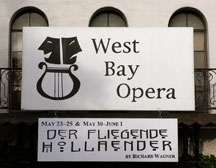 |
We had several versions of this opera to choose from while
I worked on the pages to show the costumes, the set, and to
explain the story of Der fliegende Holländer and
Stan prepared the titles. We used a thunder
machine for exciting bits like the Dutchman
and his Ghost Ship. The wave and gull sound effects came
through Tod’s O3D. In the
basement, along with the usual brass, was my very
first tuba. The abandoned
art by the back door was a mystery to everyone.
|
Top | Madama Butterfly (2009) | Orfeo ed Euridice | Carmen (2008) | Der fliegende Holländer | Così fan tutte (2008) | Cavalleria rusticana & Pagliacci | The Queen of Spades | Macbeth | The Rake’s Progress | Manon Lescaut | The Magic Flute | The Threepenny Opera | Lucia di Lammermoor | La Clemenza di Tito | Don Giovanni | The Barber of Seville | Viva la mamma | La Périchole | Un ballo in maschera | Tosca | La bohème | Marriage of Figaro | Faust | Tales of Hoffmann | Tartuffe | La Traviata | City of Mahagonny | Così fan tutte | Madama Butterfly (1999) | The Consul | Carmen | The Italian Girl in Algiers | The Turn of the Screw | Il Trovatore
| Così fan
tutte (2008) |
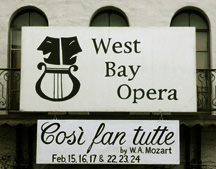 |
This opera is our first West Bay Opera repeat, since we also
worked the 2000 Così fan tutte production.
It was interesting to notice the differences as I worked on
the pages to show the costumes, the set, and to explain the
story of Così fan tutte. Since I love this opera,
the repeat is fine with me, but Stan thinks there just might
be too many words. In the paint shop, the heads
are in charge and have arranged a Still
Life with Ladder. The mustaches await
their call in the tech office, and the
boat drowses USR, and the
columns lounge against the back wall.
And I finally remembered to take a picture of the Lucie
Stern Theatre. |
Top | Madama Butterfly (2009) | Orfeo ed Euridice | Carmen (2008) | Der fliegende Holländer | Così fan tutte (2008) | Cavalleria rusticana & Pagliacci | The Queen of Spades | Macbeth | The Rake’s Progress | Manon Lescaut | The Magic Flute | The Threepenny Opera | Lucia di Lammermoor | La Clemenza di Tito | Don Giovanni | The Barber of Seville | Viva la mamma | La Périchole | Un ballo in maschera | Tosca | La bohème | Marriage of Figaro | Faust | Tales of Hoffmann | Tartuffe | La Traviata | City of Mahagonny | Così fan tutte | Madama Butterfly (1999) | The Consul | Carmen | The Italian Girl in Algiers | The Turn of the Screw | Il Trovatore
| Cavalleria
rusticana & Pagliacci (2007) |
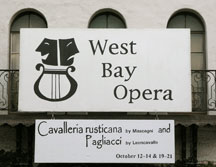 |
This pair was confusing, since we had two operas to listen
to while I worked on pages to show the costumes and the set
and Stan prepared the titles. Getting the truck
in place for Pagliacci was a daily struggle for Will and
Laszlo. The chicken always
startled me backstage, but was hilarious onstage.
|
Top | Madama Butterfly (2009) | Orfeo ed Euridice | Carmen (2008) | Der fliegende Holländer | Così fan tutte (2008) | Cavalleria rusticana & Pagliacci | The Queen of Spades | Macbeth | The Rake’s Progress | Manon Lescaut | The Magic Flute | The Threepenny Opera | Lucia di Lammermoor | La Clemenza di Tito | Don Giovanni | The Barber of Seville | Viva la mamma | La Périchole | Un ballo in maschera | Tosca | La bohème | Marriage of Figaro | Faust | Tales of Hoffmann | Tartuffe | La Traviata | City of Mahagonny | Così fan tutte | Madama Butterfly (1999) | The Consul | Carmen | The Italian Girl in Algiers | The Turn of the Screw | Il Trovatore
| The
Queen of Spades (2007) |
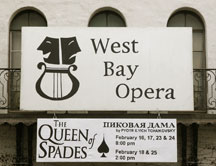 |
To prepare for this opera we dug out my old copy of The
Complete Prose Tales of Alexandr Sergeyevitch Pushkin to
reread “The Queen of Spades,” the story the opera
is based on. Then we listened to Tchaikovsky’s music
while I worked on pages to show the costumes, the set, and
to explain the story of The Queen of Spades and Stan
prepared the titles. The opera was performed in Russian,
but luckily we had a trilingual French
Rat to help with sound, especially during the Big
Bell cue. Ian helped us setup and Emily was the titles
overseer.
|
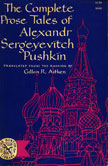 |
Top | Madama Butterfly (2009) | Orfeo ed Euridice | Carmen (2008) | Der fliegende Holländer | Così fan tutte (2008) | Cavalleria rusticana & Pagliacci | The Queen of Spades | Macbeth | The Rake’s Progress | Manon Lescaut | The Magic Flute | The Threepenny Opera | Lucia di Lammermoor | La Clemenza di Tito | Don Giovanni | The Barber of Seville | Viva la mamma | La Périchole | Un ballo in maschera | Tosca | La bohème | Marriage of Figaro | Faust | Tales of Hoffmann | Tartuffe | La Traviata | City of Mahagonny | Così fan tutte | Madama Butterfly (1999) | The Consul | Carmen | The Italian Girl in Algiers | The Turn of the Screw | Il Trovatore
| Macbeth
(2006) |
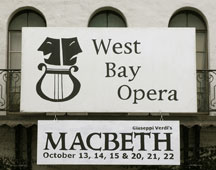 |
We knew the Scottish play, of course, but weren’t too
familiar with this opera before listening to it while I worked
on pages to show the costumes, the set, and to explain the story
of Macbeth and Stan prepared the titles. Ian helped
us setup and Emily was the titles
overseer.
|
Top | Madama Butterfly (2009) | Orfeo ed Euridice | Carmen (2008) | Der fliegende Holländer | Così fan tutte (2008) | Cavalleria rusticana & Pagliacci | The Queen of Spades | Macbeth | The Rake’s Progress | Manon Lescaut | The Magic Flute | The Threepenny Opera | Lucia di Lammermoor | La Clemenza di Tito | Don Giovanni | The Barber of Seville | Viva la mamma | La Périchole | Un ballo in maschera | Tosca | La bohème | Marriage of Figaro | Faust | Tales of Hoffmann | Tartuffe | La Traviata | City of Mahagonny | Così fan tutte | Madama Butterfly (1999) | The Consul | Carmen | The Italian Girl in Algiers | The Turn of the Screw | Il Trovatore
| The
Rake’s Progress (2006) |
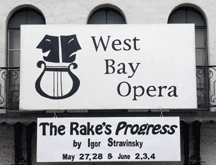 |
This is one of Stan’s favorite operas, so we had several
versions of this opera to listen to while I worked on the pages
to show the costumes, the
set, and to explain The
Story of The Rake’s Progress and Stan prepared
the titles. My favorite props were the lampshades that
silenced Baba the Turk and started a new fashion in hats. Here
are some performance
pictures and the program for
the opera. |
Top | Madama Butterfly (2009) | Orfeo ed Euridice | Carmen (2008) | Der fliegende Holländer | Così fan tutte (2008) | Cavalleria rusticana & Pagliacci | The Queen of Spades | Macbeth | The Rake’s Progress | Manon Lescaut | The Magic Flute | The Threepenny Opera | Lucia di Lammermoor | La Clemenza di Tito | Don Giovanni | The Barber of Seville | Viva la mamma | La Périchole | Un ballo in maschera | Tosca | La bohème | Marriage of Figaro | Faust | Tales of Hoffmann | Tartuffe | La Traviata | City of Mahagonny | Così fan tutte | Madama Butterfly (1999) | The Consul | Carmen | The Italian Girl in Algiers | The Turn of the Screw | Il Trovatore
| Manon
Lescaut (2006) |
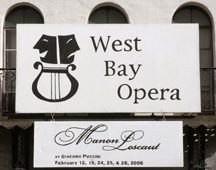 |
We had several versions of this opera to choose from while
I worked on the pages to show the costumes, the
set, and to explain The
Story of Manon Lescaut and Stan prepared the titles.
We had to buy some new talkies since
someone stole our old ones. There was a cute gobo waiting
for us in the booth. My favorite set piece was the chandelier
which looked much better on
stage than hanging
around in the paint shop. Here are some performance
pictures and the program for
the opera. |
Top | Madama Butterfly (2009) | Orfeo ed Euridice | Carmen (2008) | Der fliegende Holländer | Così fan tutte (2008) | Cavalleria rusticana & Pagliacci | The Queen of Spades | Macbeth | The Rake’s Progress | Manon Lescaut | The Magic Flute | The Threepenny Opera | Lucia di Lammermoor | La Clemenza di Tito | Don Giovanni | The Barber of Seville | Viva la mamma | La Périchole | Un ballo in maschera | Tosca | La bohème | Marriage of Figaro | Faust | Tales of Hoffmann | Tartuffe | La Traviata | City of Mahagonny | Così fan tutte | Madama Butterfly (1999) | The Consul | Carmen | The Italian Girl in Algiers | The Turn of the Screw | Il Trovatore
| The
Magic Flute (2005) |
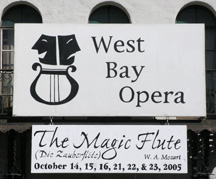 |
We listened to several versions of this opera while I worked
on the pages to show the costumes,
the set model, and to explain the story of The Magic Flute.
We even watched the Bergman movie and were disconcerted by familiar
songs sung in Swedish. For some reason a strange basket
of limbs was delivered to the lobby during rehearsals. Ian
and I figured out how to load sound files on the sampler since
I had lots of fun sound cues full of crashing thunder to herald
the arrival and departure of the Queen of the Night. We borrowed
a beautiful celeste to play
the sound of Papageno’s Magic Bells. The booth
serpent helped to call the sound cues while the bed
snake prepared to pounce on Tamino.
|
Top | Madama Butterfly (2009) | Orfeo ed Euridice | Carmen (2008) | Der fliegende Holländer | Così fan tutte (2008) | Cavalleria rusticana & Pagliacci | The Queen of Spades | Macbeth | The Rake’s Progress | Manon Lescaut | The Magic Flute | The Threepenny Opera | Lucia di Lammermoor | La Clemenza di Tito | Don Giovanni | The Barber of Seville | Viva la mamma | La Périchole | Un ballo in maschera | Tosca | La bohème | Marriage of Figaro | Faust | Tales of Hoffmann | Tartuffe | La Traviata | City of Mahagonny | Così fan tutte | Madama Butterfly (1999) | The Consul | Carmen | The Italian Girl in Algiers | The Turn of the Screw | Il Trovatore
| The
Threepenny Opera (2005) |
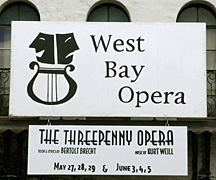 |
We had to check this opera out of the library to listen to
while I worked on the pages to show the costumes, the set sketches,
and the set model, and to explain the story of The Threepenny
Opera, though we did have many many versions of “Mack
the Knife.” Stan got some nifty
title screens for this show. Since the orchestra was onstage
I didn’t have much to do—only one
wire so the conductor could hear the singers downstage.
I had plenty of time to capture the yellow
chain and paint spotch in
the paint shop. The sets and lighting for this opera were tremendous—here
is a closeup of the Bordello
stairs and the stage manager adjusting
the moon. The bordello girls were often just
a blur of color and light. My favorite prop for this show
was Victoria’s
messenger’s horse, though the red
couch was a close second. The spotlight also
adored the couch.
|
Top | Madama Butterfly (2009) | Orfeo ed Euridice | Carmen (2008) | Der fliegende Holländer | Così fan tutte (2008) | Cavalleria rusticana & Pagliacci | The Queen of Spades | Macbeth | The Rake’s Progress | Manon Lescaut | The Magic Flute | The Threepenny Opera | Lucia di Lammermoor | La Clemenza di Tito | Don Giovanni | The Barber of Seville | Viva la mamma | La Périchole | Un ballo in maschera | Tosca | La bohème | Marriage of Figaro | Faust | Tales of Hoffmann | Tartuffe | La Traviata | City of Mahagonny | Così fan tutte | Madama Butterfly (1999) | The Consul | Carmen | The Italian Girl in Algiers | The Turn of the Screw | Il Trovatore
| Lucia
di Lammermoor (2005) |
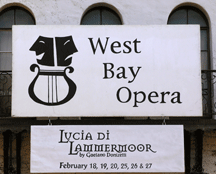 |
After watching the I Claudius series, we looked
in the library for some pictures of Roman eagles as a possible
design for the 2004 Solstice card. We didn’t find the
eagles, but a book on Irish art reminded us of a newspaper article
describing our next show as Lucia di Lammermoo, so
we ended up with a Flying Cow instead.
We watched Akira’s video of Edita Gruberova as Lucia while
I worked on the page to explain the story of Lucia di Lammermoor and
a page with the costume
sketches. We had some help in the booth this show. Stan’s
faithful Piccolo brought
the titles and Ice Bat kept
the patch cables in line. My favorite red
chair was often hanging out in the Green Room while the candlesticks hid
out in the paint shop.
|
Top | Madama Butterfly (2009) | Orfeo ed Euridice | Carmen (2008) | Der fliegende Holländer | Così fan tutte (2008) | Cavalleria rusticana & Pagliacci | The Queen of Spades | Macbeth | The Rake’s Progress | Manon Lescaut | The Magic Flute | The Threepenny Opera | Lucia di Lammermoor | La Clemenza di Tito | Don Giovanni | The Barber of Seville | Viva la mamma | La Périchole | Un ballo in maschera | Tosca | La bohème | Marriage of Figaro | Faust | Tales of Hoffmann | Tartuffe | La Traviata | City of Mahagonny | Così fan tutte | Madama Butterfly (1999) | The Consul | Carmen | The Italian Girl in Algiers | The Turn of the Screw | Il Trovatore
| Don
Giovanni (2004) |
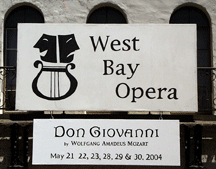 |
We had several versions of this opera to listen to while
working on the pages to show the set sketches, and the set model,
and to explain the story of Don Giovanni. The projection of
the Commendatore was the trickiest part for the crew. ASM Tricia
Tani holds some snacks for
Don Giovanni’s party while the
wine waits backstage.
|
Top | Madama Butterfly (2009) | Orfeo ed Euridice | Carmen (2008) | Der fliegende Holländer | Così fan tutte (2008) | Cavalleria rusticana & Pagliacci | The Queen of Spades | Macbeth | The Rake’s Progress | Manon Lescaut | The Magic Flute | The Threepenny Opera | Lucia di Lammermoor | La Clemenza di Tito | Don Giovanni | The Barber of Seville | Viva la mamma | La Périchole | Un ballo in maschera | Tosca | La bohème | Marriage of Figaro | Faust | Tales of Hoffmann | Tartuffe | La Traviata | City of Mahagonny | Così fan tutte | Madama Butterfly (1999) | The Consul | Carmen | The Italian Girl in Algiers | The Turn of the Screw | Il Trovatore
| The
Barber of Seville (2004) |
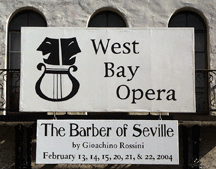 |
We had lots of options to listen to while I worked on the
pages to show the set sketches, and the set model, and to explain
the story of The Barber of Seville. I loved the colors
of the set for this opera. Figaro’s
wagon waited patiently in the Green Room and a barber
pole appeared here and there. The bass liked
to hang out in my favorite Keep This Space Clear corner backstage.
We borrrowed a thunder
machine for the storm scene and I had a sound
effect to create the breaking glass diversion. Before the
last Sunday performance the spot
ops made a rare appearance onstage.
|
Top | Madama Butterfly (2009) | Orfeo ed Euridice | Carmen (2008) | Der fliegende Holländer | Così fan tutte (2008) | Cavalleria rusticana & Pagliacci | The Queen of Spades | Macbeth | The Rake’s Progress | Manon Lescaut | The Magic Flute | The Threepenny Opera | Lucia di Lammermoor | La Clemenza di Tito | Don Giovanni | The Barber of Seville | Viva la mamma | La Périchole | Un ballo in maschera | Tosca | La bohème | Marriage of Figaro | Faust | Tales of Hoffmann | Tartuffe | La Traviata | City of Mahagonny | Così fan tutte | Madama Butterfly (1999) | The Consul | Carmen | The Italian Girl in Algiers | The Turn of the Screw | Il Trovatore
| Viva
la mamma! (2003) |
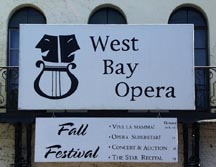 |
We had to borrow a CD to listen to while working on the
page to explain the story of Viva la mamma. We were
amazed when we entered the Booth to find a new
light board that looks capable of piloting the Starship
Enterprise. Only Corinne has
a license to operate it! The props in this show were great.
Luigia had a hilarious pair
of glasses, Stefano wore a wonderful breastplate,
and Mamma rescued the show with her box
of jewels. Backstage there was some
hair waiting to make an entrance and a beautiful amber
light.
During the Fall Festival, footprints appeared
on the stage so the SuperStar contestants would know where
to stand. And the genie looked
romantic in Corrine’s special light. |
Top | Madama Butterfly (2009) | Orfeo ed Euridice | Carmen (2008) | Der fliegende Holländer | Così fan tutte (2008) | Cavalleria rusticana & Pagliacci | The Queen of Spades | Macbeth | The Rake’s Progress | Manon Lescaut | The Magic Flute | The Threepenny Opera | Lucia di Lammermoor | La Clemenza di Tito | Don Giovanni | The Barber of Seville | Viva la mamma | La Périchole | Un ballo in maschera | Tosca | La bohème | Marriage of Figaro | Faust | Tales of Hoffmann | Tartuffe | La Traviata | City of Mahagonny | Così fan tutte | Madama Butterfly (1999) | The Consul | Carmen | The Italian Girl in Algiers | The Turn of the Screw | Il Trovatore
| La
Périchole (2003) |
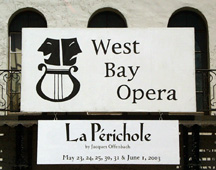 |
We had to go out and buy a CD to listen to while working
on the pages to show the set sketches, and the set model, and
to explain the story of La Périchole. I was glad
to hear the “Hop La” refrain, which will keep MR
amused while running spots in the beams. As usual, there was
a mysterious new Do Not
Move sign on the rail as well as a pair of strange new
clamps. While wandering around aimlessly before the shows,
I found this wonderful Still
Life with Work Light and Flags backstage and a great Composition
with Two Brooms onstage. The set is marvelous up
close and seen from
a distance as Stan focuses the supertitles and Will checks
the molding. My favorite set detail is the
rat perched on top of the fountain fondly referred to as
the pissoire by the crew. You can tell this is not a
performance, since Stan is not
wearing black and the booth is bright! The new booth mascot
is the glow in the dark
gecko Michele gave me to keep the booth crew amused.
|
Top | Madama Butterfly (2009) | Orfeo ed Euridice | Carmen (2008) | Der fliegende Holländer | Così fan tutte (2008) | Cavalleria rusticana & Pagliacci | The Queen of Spades | Macbeth | The Rake’s Progress | Manon Lescaut | The Magic Flute | The Threepenny Opera | Lucia di Lammermoor | La Clemenza di Tito | Don Giovanni | The Barber of Seville | Viva la mamma | La Périchole | Un ballo in maschera | Tosca | La bohème | Marriage of Figaro | Faust | Tales of Hoffmann | Tartuffe | La Traviata | City of Mahagonny | Così fan tutte | Madama Butterfly (1999) | The Consul | Carmen | The Italian Girl in Algiers | The Turn of the Screw | Il Trovatore
| Un ballo in maschera
(2003) |
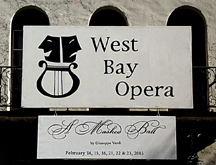 |
I listened mainly to Act Two while I worked on the pages
to show the set sketches and explain the story of Un ballo in maschera.
We found Corrine a new friend to
help her with the Light Board. She probably looks a bit dazed
from the fumes caused by de-oxidizing the
patch panel. Some of the crew members are having such a
good time that they hang out by the Sign-In
Board for hours on end. Mia carried this giant
hand as part of her Fortune Teller’s costume for the
masked ball. And we used lots of dry
ice to make the foggy, misty, swirly atmosphere.
|
Top | Madama Butterfly (2009) | Orfeo ed Euridice | Carmen (2008) | Der fliegende Holländer | Così fan tutte (2008) | Cavalleria rusticana & Pagliacci | The Queen of Spades | Macbeth | The Rake’s Progress | Manon Lescaut | The Magic Flute | The Threepenny Opera | Lucia di Lammermoor | La Clemenza di Tito | Don Giovanni | The Barber of Seville | Viva la mamma | La Périchole | Un ballo in maschera | Tosca | La bohème | Marriage of Figaro | Faust | Tales of Hoffmann | Tartuffe | La Traviata | City of Mahagonny | Così fan tutte | Madama Butterfly (1999) | The Consul | Carmen | The Italian Girl in Algiers | The Turn of the Screw | Il Trovatore
| Tosca
(2002) |
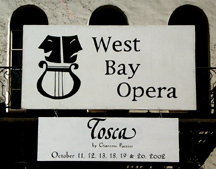 |
We had lots of versions of this opera to listen to while
I worked on the pages to show the set sketches and explain the
story of Tosca. The Te Deum at the end of Act 1 is
my very favorite part. I listened to it over and over and over
and over and … My favorite set piece was the Madonna who
always looked comfortable—waiting
patiently for her cue in the paint shop, listening
to the paint cans, or in her proper place in the church.
But the Angelotti dummy never
seemed to be able to relax. Chad made Stan a new snoot
for the projectors to mask the extra light and Laszlo helped check
the centering on the screens. Stan’s keypad became
even more colorful this show. Drew and I couldn’t figure
out for the longest time how to adjust the volume on the lobby
TV. In the dark using only a flashlight (with Jack’s help),
we finally found it under the table in the booth—it’s
the bit marked with yellow tape.
I had the cannon and church bells to keep me amused, but still
had enough extra time to count all of the various controls I
have to play with on the sound board: 25 sliders, 174 knobs,
and 200 buttons! My favorite percussion bit was Norm’s sheep
bells. There is a new mark on the wall outside the booth—we
hope it isn’t as ominous
a sign as it appears to be. If so we can always use the escape
stairs in the parking lot.
|
Top | Madama Butterfly (2009) | Orfeo ed Euridice | Carmen (2008) | Der fliegende Holländer | Così fan tutte (2008) | Cavalleria rusticana & Pagliacci | The Queen of Spades | Macbeth | The Rake’s Progress | Manon Lescaut | The Magic Flute | The Threepenny Opera | Lucia di Lammermoor | La Clemenza di Tito | Don Giovanni | The Barber of Seville | Viva la mamma | La Périchole | Un ballo in maschera | Tosca | La bohème | Marriage of Figaro | Faust | Tales of Hoffmann | Tartuffe | La Traviata | City of Mahagonny | Così fan tutte | Madama Butterfly (1999) | The Consul | Carmen | The Italian Girl in Algiers | The Turn of the Screw | Il Trovatore
| La
bohème (2002) |
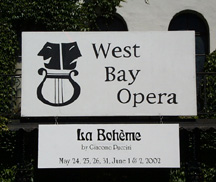 |
We had lots of versions of this opera to listen to while
I worked on the pages to show the set sketches and explain the
story of La bohème. With this show, Stan made
the transition to computerized supertitles.
They are easier to fix if there are errors, but with 731 to
show, he doesn’t have much time to see what
they look like. Stan had to make do with a substitute TV
monitor to watch the conductor since his favorite little red
one was hanging out in the paint
shop with Parpignol’s toy cart, which somehow also
managed to get squashed
into the corner by the Green Room door. My favorite part
of the set is the Chapeau du
Chat which looks inviting from any
angle or as part of the Latin
Quarter street. Janny sits on the Genie next to Café Momus,
ready to shine her spot on
Mimì and Rodolfo. On top of his normal percussion assortment,
Norm plays the bicchieri—in
the score described as “glasses played with a table knife,” but
Norm uses sticks. In the corner of the stage behind the percussion
is a dressing room for
the chorus quick change. The props table holds the snow
machine (which I’m positive has more wires than it
really needs) and some pastries that
look almost good enough to eat. Jack is still in Texas, so I
had to rely on outside assistance to
keep the cables in proper order.
|
Top | Madama Butterfly (2009) | Orfeo ed Euridice | Carmen (2008) | Der fliegende Holländer | Così fan tutte (2008) | Cavalleria rusticana & Pagliacci | The Queen of Spades | Macbeth | The Rake’s Progress | Manon Lescaut | The Magic Flute | The Threepenny Opera | Lucia di Lammermoor | La Clemenza di Tito | Don Giovanni | The Barber of Seville | Viva la mamma | La Périchole | Un ballo in maschera | Tosca | La bohème | Marriage of Figaro | Faust | Tales of Hoffmann | Tartuffe | La Traviata | City of Mahagonny | Così fan tutte | Madama Butterfly (1999) | The Consul | Carmen | The Italian Girl in Algiers | The Turn of the Screw | Il Trovatore
| Marriage
of Figaro (2002) |
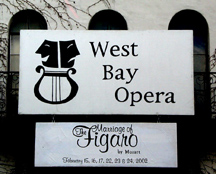 |
We had lots of versions of this opera to listen to while
working on the pages to show the set and explain the story of Figaro.
I love the details in Callie Floor’s costume sketches,
especially the villagers.
This was my first show without Jack, and I was very nervous,
so Michele bought me some new talkie
toys to make me feel better. To start the show, the crew
built incredible piles of
junk that the chorus carted away during the overture. Some
of the special bits liked to hang out next to the timpani
TV. To make the suspicious sound in the Countess’s
closet, the crew experimented with various objects inside the crash
box, but nothing was loud enough until finally Steve knocked
the whole crash box over! The set was so big that the ASM had
to build a cosy nest inside the DSL
closet. The statue added
a touch of class to the paint shop while waiting for its grand
entrance in Act IV. I loved looking at things close
up almost as much as my usual view
from the booth. At the first Sunday performance, the button
Stan uses to advance the supertitle slides gave up the ghost.
The new change button doesn’t
give as much positive feedback, but it does work!
|
Top | Madama Butterfly (2009) | Orfeo ed Euridice | Carmen (2008) | Der fliegende Holländer | Così fan tutte (2008) | Cavalleria rusticana & Pagliacci | The Queen of Spades | Macbeth | The Rake’s Progress | Manon Lescaut | The Magic Flute | The Threepenny Opera | Lucia di Lammermoor | La Clemenza di Tito | Don Giovanni | The Barber of Seville | Viva la mamma | La Périchole | Un ballo in maschera | Tosca | La bohème | Marriage of Figaro | Faust | Tales of Hoffmann | Tartuffe | La Traviata | City of Mahagonny | Così fan tutte | Madama Butterfly (1999) | The Consul | Carmen | The Italian Girl in Algiers | The Turn of the Screw | Il Trovatore
| Faust
(2001) |
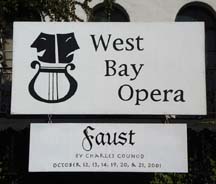 |
I had to listen to this opera on LP while working on the
page to explain the story of Faust since we didn’t
have it on CD—not a good sign! But I loved Anna Björnsdotter’s
costume sketches. My favorite is probably the line of village
women. The real costumes are even more amazing—each
one is different and they are much softer than they look. Jean-François
Revon’s church drop was my favorite set bit at first,
especially the view from the
orchestra pit. The Hell Gate scared me when we first met,
but then I caught it creeping
up on the pit rope one evening and we bonded. Now I think
it is adorable as it prepares
to devour the chairs and the Heaven Gate during a break
in the sitzprobe. The Heaven
Gate is nice, but just doesn't have as much personality.
Don is playing timpani in
the corner backstage next to the wonderful still
life with dustpan. The rectangle taped down stage left for
the percussion was big enough for the
instruments or Norm, but not
both so we had to enlarge it. The organ is
behind the cyc in a very long and narrow space and the harp is
snugged into the downstage corner behind the ASM. During the
Garden Scene a light comes on behind Stan in the booth, so he
has a “chapeau” cue to
remind himself to put on his cap. The light does give him a healthy
glow as he runs the supertitles.
|
Top | Madama Butterfly (2009) | Orfeo ed Euridice | Carmen (2008) | Der fliegende Holländer | Così fan tutte (2008) | Cavalleria rusticana & Pagliacci | The Queen of Spades | Macbeth | The Rake’s Progress | Manon Lescaut | The Magic Flute | The Threepenny Opera | Lucia di Lammermoor | La Clemenza di Tito | Don Giovanni | The Barber of Seville | Viva la mamma | La Périchole | Un ballo in maschera | Tosca | La bohème | Marriage of Figaro | Faust | Tales of Hoffmann | Tartuffe | La Traviata | City of Mahagonny | Così fan tutte | Madama Butterfly (1999) | The Consul | Carmen | The Italian Girl in Algiers | The Turn of the Screw | Il Trovatore
| Les
contes d’Hoffmann (2001) |
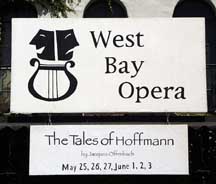 |
While listening to this opera on CD, I worked on a page to
explain the story of Les contes d’Hoffmann. Jean-François
Revon designed an amazing set and I have fallen in love with
Callie Floor’s Cochenille
costume. The set takes up the whole stage, so there wasn’t
room for the percussion. For the first time in my tenure, the flat
dock was emptied, except for the flats.
An amazing new elevator with impressive controls appeared
in the basement to hoist things like Antonia’s
chair. The props designed by Valda Lake are incredible.
My favorite is Olympia’s
harp, though her heart and arm are
also wonderful. During rehearsals it is easy to stumble over
surreal objects like the flat chorus
costumes, Antonia’s
piano, the cage of love,
and a very large earlobe hiding
behind the lights.
|
Top | Madama Butterfly (2009) | Orfeo ed Euridice | Carmen (2008) | Der fliegende Holländer | Così fan tutte (2008) | Cavalleria rusticana & Pagliacci | The Queen of Spades | Macbeth | The Rake’s Progress | Manon Lescaut | The Magic Flute | The Threepenny Opera | Lucia di Lammermoor | La Clemenza di Tito | Don Giovanni | The Barber of Seville | Viva la mamma | La Périchole | Un ballo in maschera | Tosca | La bohème | Marriage of Figaro | Faust | Tales of Hoffmann | Tartuffe | La Traviata | City of Mahagonny | Così fan tutte | Madama Butterfly (1999) | The Consul | Carmen | The Italian Girl in Algiers | The Turn of the Screw | Il Trovatore
| Tartuffe
(2001) |
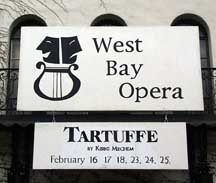 |
This opera has some wonderful rhyming couplets which Stan
busily typed into the supertitles while I played around with
pictures to illustrate the story of Tartuffe. My father
gave me a frog fetish that
I named Tartuffe, though you can see that he is a totally sincere
creature and not a “sanctimonious toad.” Since
the whole opera takes place in one day, the set does
not move. Here is stage
left, stage right,
and the patio. While
waiting for calls, the singers can watch the stage from the monitor in
the Green Room. The harp is
tucked into the downstage left corner. Don has so many instruments
to play (including the temple
blocks and glockenspiel) that he is usually just
a blur. The percussion area on stage is outlined
with tape, right next to another of those mysterious clear
walls. The stage left stair entrance for the singers glow
with an eerie blue and green during
performances. My only sound effect is Tartuffe’s knock
of fate so I had plenty of time during the piano dress rehearsals
to take pictures of the paint
shop wall and this great still
life with dusters. The opera sounded and looked great.
|
Top | Madama Butterfly (2009) | Orfeo ed Euridice | Carmen (2008) | Der fliegende Holländer | Così fan tutte (2008) | Cavalleria rusticana & Pagliacci | The Queen of Spades | Macbeth | The Rake’s Progress | Manon Lescaut | The Magic Flute | The Threepenny Opera | Lucia di Lammermoor | La Clemenza di Tito | Don Giovanni | The Barber of Seville | Viva la mamma | La Périchole | Un ballo in maschera | Tosca | La bohème | Marriage of Figaro | Faust | Tales of Hoffmann | Tartuffe | La Traviata | City of Mahagonny | Così fan tutte | Madama Butterfly (1999) | The Consul | Carmen | The Italian Girl in Algiers | The Turn of the Screw | Il Trovatore
Top | Madama Butterfly (2009) | Orfeo ed Euridice | Carmen (2008) | Der fliegende Holländer | Così fan tutte (2008) | Cavalleria rusticana & Pagliacci | The Queen of Spades | Macbeth | The Rake’s Progress | Manon Lescaut | The Magic Flute | The Threepenny Opera | Lucia di Lammermoor | La Clemenza di Tito | Don Giovanni | The Barber of Seville | Viva la mamma | La Périchole | Un ballo in maschera | Tosca | La bohème | Marriage of Figaro | Faust | Tales of Hoffmann | Tartuffe | La Traviata | City of Mahagonny | Così fan tutte | Madama Butterfly (1999) | The Consul | Carmen | The Italian Girl in Algiers | The Turn of the Screw | Il Trovatore
| Aufstieg
und Fall der Stadt Mahagonny (2000) |
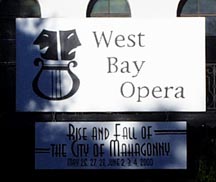 |
“Mahagonny” means “spider web” and
the city of Mahagonny spreads its web throughout the opera.
The city begins with a only a hand-painted
sign, but soon adds a motel with
a kicking leg sign and
a gambling saloon which
offers free cash. Hurricanes
(which look a lot like tornados to
me) threaten the city, and the men’s chorus gets to wear
these amazing city hats. I
love the neon signs even when
they are not lit. The orchestra
is at the back of the stage, at the end of the
road, the orchestra lights twinkle through the scrim. My baby
grand piano looks beautiful and sounds even better. My big
moment is making sure the mandolin is not overwhelmed by the
bandoneon during their duet while O’Brien eats “two
calves, head to crupper.” And Chris even trusted his silver
cup to me long enough to dress it up and take a picture.
It was difficult to take my traditional sign picture since the
courtyard is all fenced off.
And here is my very first web movie (filmed
by Jack) — the WBO crew getting the stage ready for the opera. |
Top | Madama Butterfly (2009) | Orfeo ed Euridice | Carmen (2008) | Der fliegende Holländer | Così fan tutte (2008) | Cavalleria rusticana & Pagliacci | The Queen of Spades | Macbeth | The Rake’s Progress | Manon Lescaut | The Magic Flute | The Threepenny Opera | Lucia di Lammermoor | La Clemenza di Tito | Don Giovanni | The Barber of Seville | Viva la mamma | La Périchole | Un ballo in maschera | Tosca | La bohème | Marriage of Figaro | Faust | Tales of Hoffmann | Tartuffe | La Traviata | City of Mahagonny | Così fan tutte | Madama Butterfly (1999) | The Consul | Carmen | The Italian Girl in Algiers | The Turn of the Screw | Il Trovatore
| Così fan
tutte (2000) |
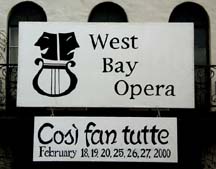 |
Rehearsals for this opera were exciting since it rained like
crazy. When we left for the Sunday sitzprobe at 6:00 PM, the
San Francisquito Creek at the Chaucer bridge was at -6
feet. Coming home after the sitz at 11:00 PM the water was nearly
to the top and we saw neighbors we hadn’t seen since
the last flood! The opera opens with a dim
view of the pool room lit by candle light. My favorite part
of the set is the wonderful little pool
table. It appears and reappears as the set rotates with
a touch of this magic red lever,
which lives back stage right next a totally mystifying Do
NOT Fly sign. There is also a tempting red
ladder (which I am not allowed to
climb) ascending through the ceiling. Here are my trumpets waiting
patiently for their turn and my harpsichord.
Red is the new color scheme in the booth. As he runs the supertitles,
Stan can follow the conductor on his little
red TV and Chris makes neat packages of used
batteries while waiting for the next light cue.
|
Top | Madama Butterfly (2009) | Orfeo ed Euridice | Carmen (2008) | Der fliegende Holländer | Così fan tutte (2008) | Cavalleria rusticana & Pagliacci | The Queen of Spades | Macbeth | The Rake’s Progress | Manon Lescaut | The Magic Flute | The Threepenny Opera | Lucia di Lammermoor | La Clemenza di Tito | Don Giovanni | The Barber of Seville | Viva la mamma | La Périchole | Un ballo in maschera | Tosca | La bohème | Marriage of Figaro | Faust | Tales of Hoffmann | Tartuffe | La Traviata | City of Mahagonny | Così fan tutte | Madama Butterfly (1999) | The Consul | Carmen | The Italian Girl in Algiers | The Turn of the Screw | Il Trovatore
| Madama
Butterfly (1999) |
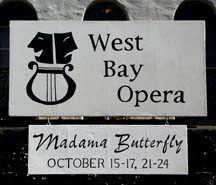 |
Stan was hard at work preparing
the supertitles for the opera, while I amused myself wondering
how Jack would make a harbor in the 1920s sound completely different
from a harbor in the 1970s. Our new harp microphone makes every
note so crystal clear that unwary sound
designers tend to bliss out. I am responsible for many jumbles
of wires, and even understand what this
bunch does! My smallest instrument is a bird
whistle and one of the most impressive is the gong.
My most exciting moment is firing
the cannon that signals the arrival of Pinkerton’s
ship in Nagasaki harbor. The lighting in this production is
beautiful; one of my favorite parts is the sunset
sequence during the humming chorus. Butterfly’s dream
of the ship at the beginning of Act III is also amazing.
Will doesn’t have the title role in this opera, but he
does have the whole stage
to himself for an entire 2 minutes during the prologue.
At night only the ghost light burns
on the stage in the empty house.
|
Top | Madama Butterfly (2009) | Orfeo ed Euridice | Carmen (2008) | Der fliegende Holländer | Così fan tutte (2008) | Cavalleria rusticana & Pagliacci | The Queen of Spades | Macbeth | The Rake’s Progress | Manon Lescaut | The Magic Flute | The Threepenny Opera | Lucia di Lammermoor | La Clemenza di Tito | Don Giovanni | The Barber of Seville | Viva la mamma | La Périchole | Un ballo in maschera | Tosca | La bohème | Marriage of Figaro | Faust | Tales of Hoffmann | Tartuffe | La Traviata | City of Mahagonny | Così fan tutte | Madama Butterfly (1999) | The Consul | Carmen | The Italian Girl in Algiers | The Turn of the Screw | Il Trovatore
| The
Consul (1999) |
This description made me wonder...
The Consul offers proof that
long-lined melody, backed by dramatic orchestration [with]
plodding rhythms and dark, repetitious motifs can convey
the accumulating weight of frustration. The power of The
Consul is in the way its score and taut, compelling libretto
mesh, expressing contemporary life as powerfully as screaming
dissonance or chaotic rhythms. — Wynne Delacoma, Chicago Sun-Times |
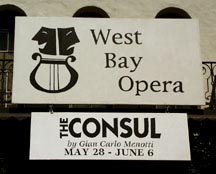 |
Stan started typing
in the supertitles for this opera during spring break
in New York City. Now he has only himself to blame if there
are too many slides! Running the sound board for this opera
is fun since I get to use Jack’s cool sampler to
run the sound effects. Ringing the phone at
exactly the right moment is my most nerve-wracking task. The percussion is
squashed into a triangle of the stage screened by drapes.
(A wall drops through a trap door into the basement spot where
the percussion lived last show.) The harp is against the stage
wall. Somehow the line of “Kafka
Zombies” manages to march between the two. The set is
totally grey and taupe, which sounds boring but is alternately beautiful
or menacing as the lighting changes. And I have fallen
in love with the wonderful little stove which
I may adopt at show’s end. The rate that I cook it might
be some before anyone noticed it was a stage prop! Will spends
most of his time onstage as a henchman for
the secret police but moonlights as the Consul. And Otak had
to master window repair skills for his role as Assan.
|
Top | Madama Butterfly (2009) | Orfeo ed Euridice | Carmen (2008) | Der fliegende Holländer | Così fan tutte (2008) | Cavalleria rusticana & Pagliacci | The Queen of Spades | Macbeth | The Rake’s Progress | Manon Lescaut | The Magic Flute | The Threepenny Opera | Lucia di Lammermoor | La Clemenza di Tito | Don Giovanni | The Barber of Seville | Viva la mamma | La Périchole | Un ballo in maschera | Tosca | La bohème | Marriage of Figaro | Faust | Tales of Hoffmann | Tartuffe | La Traviata | City of Mahagonny | Così fan tutte | Madama Butterfly (1999) | The Consul | Carmen | The Italian Girl in Algiers | The Turn of the Screw | Il Trovatore
| Carmen
(1999) |
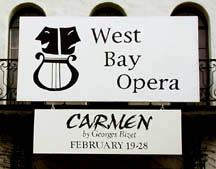 |
We wondered before this opera if the banderilleros,
the picadores, and the matador would
look anything like Robert Lawson’s illustrations from Stan’s
old copy of Munro Leaf’s The
Story of Ferdinand. (They didn’t.) After stringing
cables all over the theater, the timpani
and percussion and the harp under
the stage could see the conductor and hear the rest of the orchestra.
Going down the stairway is
like entering another world. But I spent most of my time in
the booth behind the Authorized
Personnel warning sign, running the Sound Board. Disaster
struck at the first Piano Dress Rehearsal when I slipped off
the ladder up to the
beams and damaged the radial head in my elbow. But I did get
to wear this dynamite fuchsia cast for
four weeks! (Which Jack says was quite useful for hanging cable
coils during strike…) And I was showered with cards and
flowers and even a new pet, Spike, who
was around for some time until I learned to wield a knife with
my left hand. You can see the permanent screw that now holds
my radial head together quite well in these x-rays
of my elbow.
|
Top | Madama Butterfly (2009) | Orfeo ed Euridice | Carmen (2008) | Der fliegende Holländer | Così fan tutte (2008) | Cavalleria rusticana & Pagliacci | The Queen of Spades | Macbeth | The Rake’s Progress | Manon Lescaut | The Magic Flute | The Threepenny Opera | Lucia di Lammermoor | La Clemenza di Tito | Don Giovanni | The Barber of Seville | Viva la mamma | La Périchole | Un ballo in maschera | Tosca | La bohème | Marriage of Figaro | Faust | Tales of Hoffmann | Tartuffe | La Traviata | City of Mahagonny | Così fan tutte | Madama Butterfly (1999) | The Consul | Carmen | The Italian Girl in Algiers | The Turn of the Screw | Il Trovatore
| The
Italian Girl in Algiers (1998) |
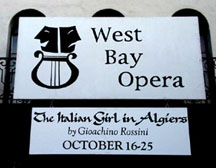 |
Jack took on the task of teaching me to be the Sound
Board Operator for this opera. I sat in the
booth above the house and had a great view of the stage.
The sound board had loads of
cool buttons and knobs and dials and levers. The orchestra pit
at West Bay Opera is too small to fit the whole orchestra. My
job was to make sure the trumpet players (in the basement underneath
the stage) and the percussion (in the storage
room behind the stage) could hear the rest of the orchestra
and that the audience could hear them. They had little TV monitors
to watch the conductor. On the other side of the booth, Stan was
running the supertitles and Chris was
running the lightboard. One thing that made this opera so much
fun was singing along with Donald Pippin’s wonderful English
version of the libretto.
|
Top | Madama Butterfly (2009) | Orfeo ed Euridice | Carmen (2008) | Der fliegende Holländer | Così fan tutte (2008) | Cavalleria rusticana & Pagliacci | The Queen of Spades | Macbeth | The Rake’s Progress | Manon Lescaut | The Magic Flute | The Threepenny Opera | Lucia di Lammermoor | La Clemenza di Tito | Don Giovanni | The Barber of Seville | Viva la mamma | La Périchole | Un ballo in maschera | Tosca | La bohème | Marriage of Figaro | Faust | Tales of Hoffmann | Tartuffe | La Traviata | City of Mahagonny | Così fan tutte | Madama Butterfly (1999) | The Consul | Carmen | The Italian Girl in Algiers | The Turn of the Screw | Il Trovatore
| The
Turn of the Screw (1998) |
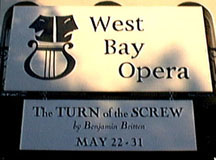 |
Projecting the ghost words for The Turn
of the Screw was
great fun. I sat all alone high
up in the beams. I could look straight down at the first few
rows of seats in the house. Stan was
in the light booth below, watching the conductor and reading
the score to be ready to advance the words at exactly the right
spot. Then I floated the ghost
words across the stage. (Michael J. Vaughn’s review in
the Palo Alto Weekly (5/29/98) referred to the drifting ghost
words as poltergeist
butterflies.) After several rehearsals, one bit the ghosts
sang about “the ceremony of innocence” kept
running around our brains. Stan tracked it down to a poem by
Yeats. On opening night an offering appeared
for the stage director, Jonathon Field. And Stan shared an email
from Emily recalling wonderful performances by Stacy
Rigg (the Governess) while at Oberlin.
|
Top | Madama Butterfly (2009) | Orfeo ed Euridice | Carmen (2008) | Der fliegende Holländer | Così fan tutte (2008) | Cavalleria rusticana & Pagliacci | The Queen of Spades | Macbeth | The Rake’s Progress | Manon Lescaut | The Magic Flute | The Threepenny Opera | Lucia di Lammermoor | La Clemenza di Tito | Don Giovanni | The Barber of Seville | Viva la mamma | La Périchole | Un ballo in maschera | Tosca | La bohème | Marriage of Figaro | Faust | Tales of Hoffmann | Tartuffe | La Traviata | City of Mahagonny | Così fan tutte | Madama Butterfly (1999) | The Consul | Carmen | The Italian Girl in Algiers | The Turn of the Screw | Il Trovatore
| Il
Trovatore (1998) |
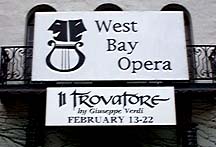 |
Our first West Bay Opera experience was learning to run the
supertitles for Il Trovatore. The fun part was climbing
up the ladder to the catwalk above
the theater and loading the slides into the carousels. It
wasn’t easy to focus the
slides on the supertitle screens. And there were rows
and rows of lights and other
mysterious stuff. But most of the time was spent in the booth following
the score intently and fading in the next supertitle at just
the right moment. After the last performance we helped to
strike the set. I became an expert at coiling the cables for
all of these lights hanging
above the stage. |
|
|

